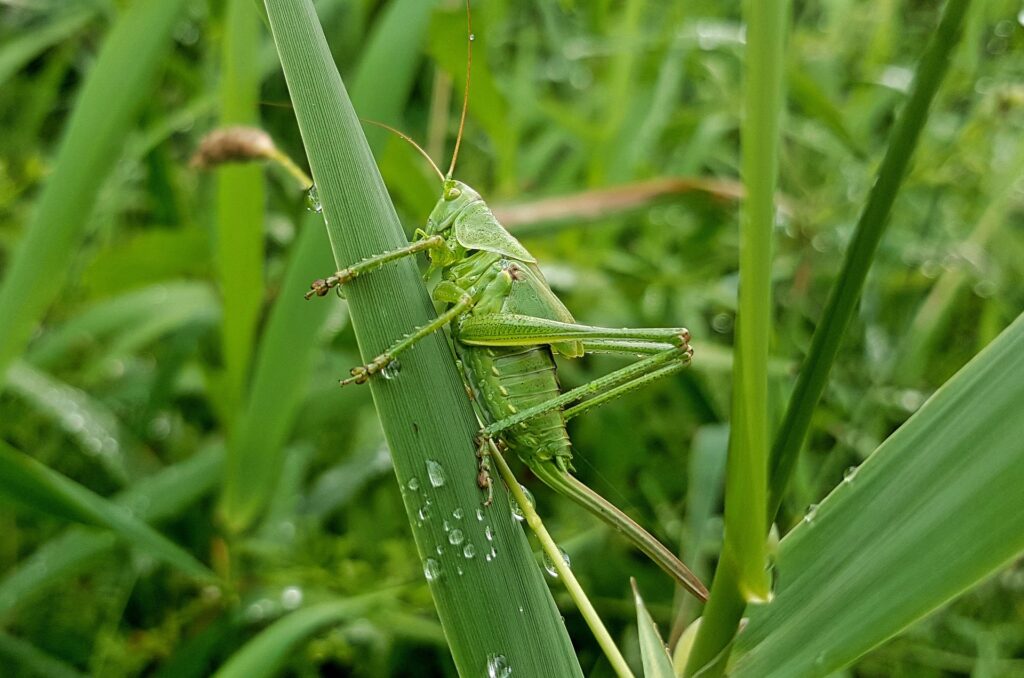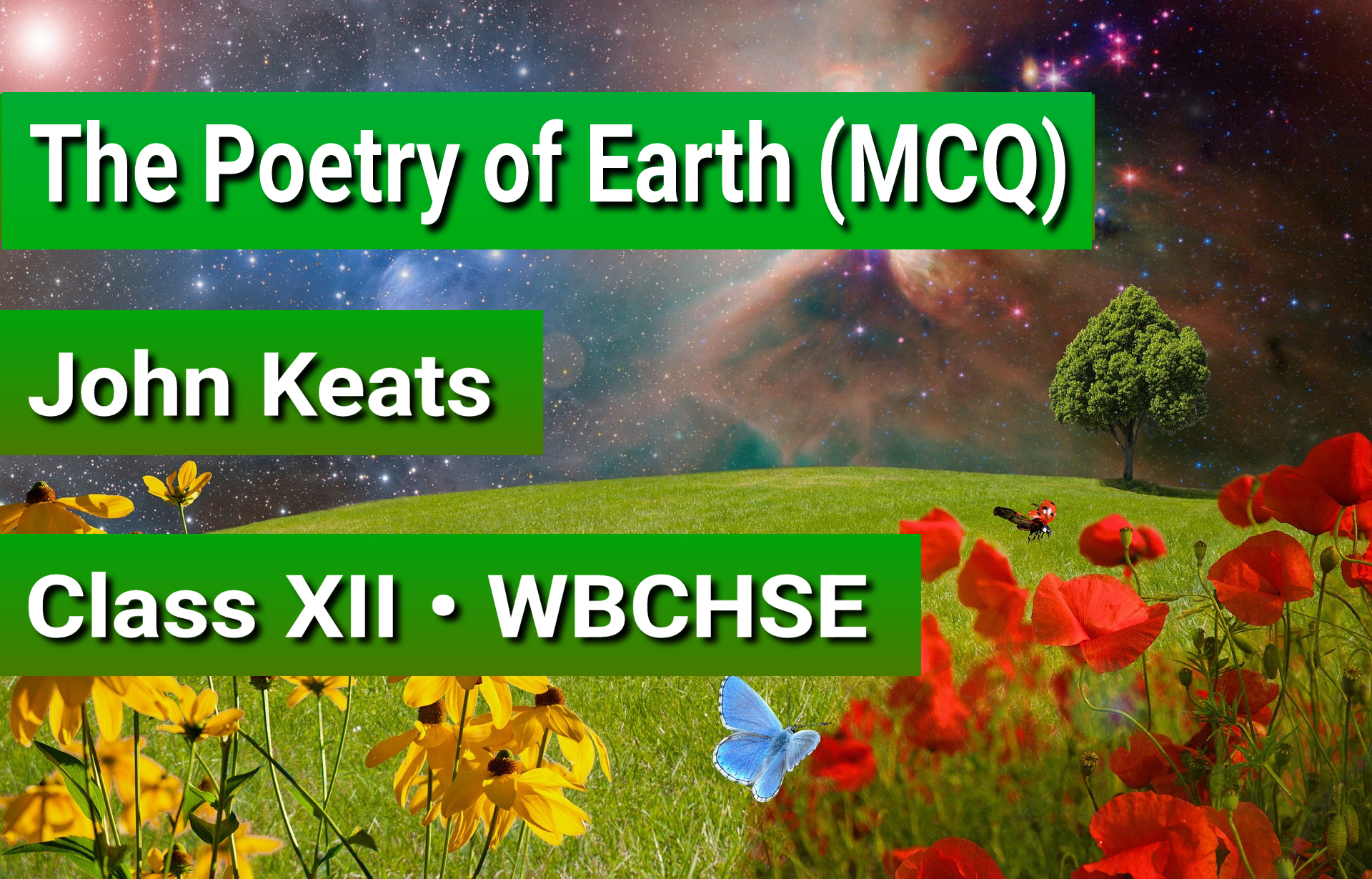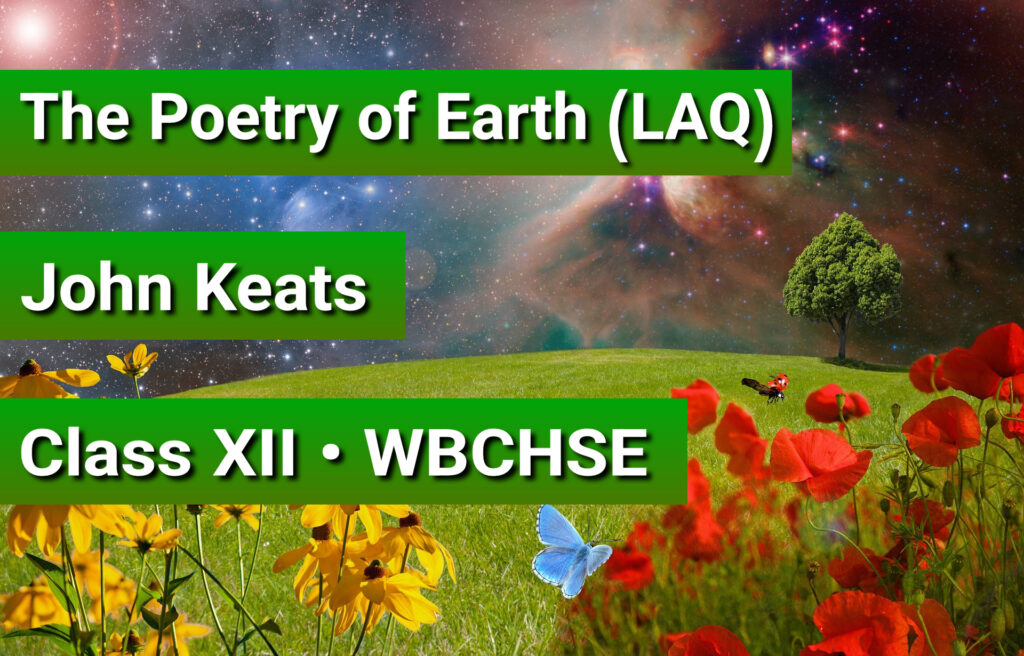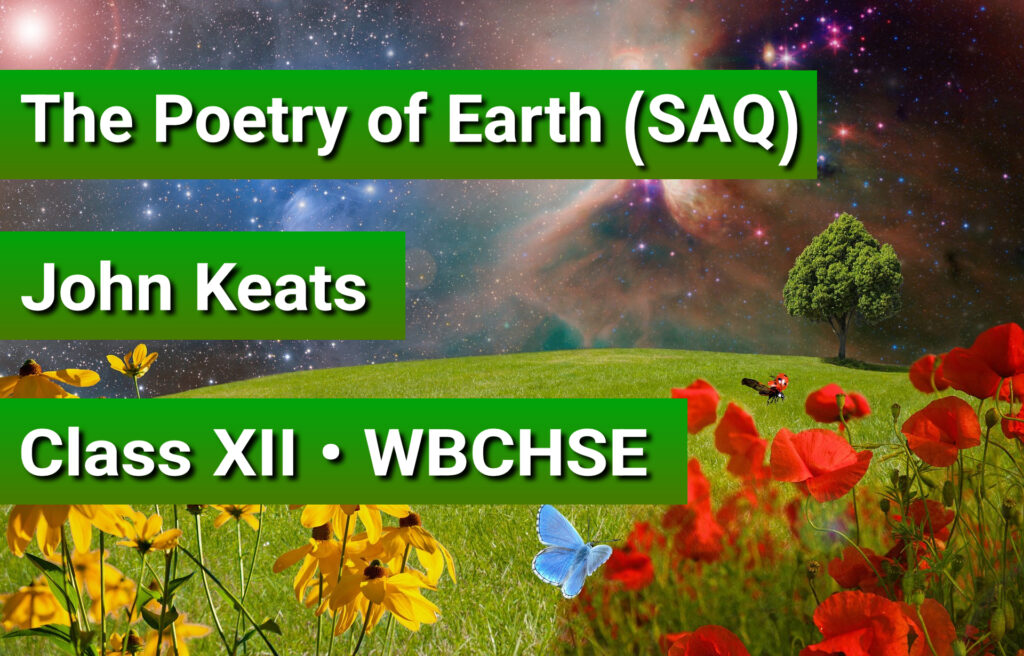The Poetry of Earth Multiple Choice Questions and Answers • The Poetry of Earth MCQ
The Poetry of Earth Questions and Answers • The Poetry of Earth Question and Answer

The Poetry of Earth by John Keats
- The ‘Poetry of Earth’ is written by –
A) John Keats
B) Gieve Patel
C) Arthur Rimbaud
D) William Shakespeare
Ans. A) John Keats
- ‘The Poetry of Earth’ is a/an –
A) ballad
B) sonnet
C) elegy
D) ode
Ans. B) sonnet
- The poem ‘The Poetry of Earth’ is a ______ sonnet.
A) Petrarchan
B) Shakespearean
C) Spenserian
D) curtailed
Ans. A) Petrarchan
- The sonnet follows the following pattern –
A) octave + sestet
B) 3 quatrains + couplet
C) sestet + sestet + couplet
D) curtail sonnet
Ans. A) octave + sestet
- The octave of the sonnet, ‘The Poetry of Earth’ follows ______ rhyme-scheme. –
A) abab abab
B) abab cd cd
C) abba abba
D) abba cddc
Ans. C) abba abba
- The sestet of the sonnet, ‘The Poetry of Earth’ follows _______ rhyme scheme. –
A) cde cde
B) cd cd cd
C) cd cd ee
D) cdc cdc
Ans. A) cde cde
- ‘The Poetry of Earth’ was written in the year –
A) 1810
B) 1812
C) 1816
D) 1818
Ans. C) 1816
- John Keats belongs to –
A) Victorian era
B) Romantic era
C) Modern era
D) Elizabethan era
Ans. B) Romantic era
- Two seasons mentioned in the poem, ‘The Poetry of Earth’ are –
A) spring & summer
B) spring & late autumn
C) winter & autumn
D) summer & winter
Ans. D) summer & winter
- In the poem, ‘The Poetry of Earth’, the poetry symbolizes –
A) nature
B) love
C) music
D) beauty
Ans. C) music
- The grasshopper is associated with the season – [HS 2016]
A) winter
B) autumn
C) summer
D) spring
Ans. C) summer.
- The birds faint during –
A) winter
B) summer
C) autumn
D) spring
Ans. B) summer
- Expressions ‘hot sun’ suggests that the season is –
A) winter
B) spring
C) autumn
D) summer
Ans. D) summer
- The birds hide in – [HS 2017]
A) Shade of trees
B) shadow of trees
C) cold trees
D) cooling trees
Ans. D) cooling tree.
- Birds hide in cooling trees because –
A) they are thirsty
B) they are weak
C) they can’t loterate summer heat
D) none of these
Ans. C) they can’t tolerate summer heat
- When birds stop singing on a hot summer day, we hear the song of a/an –
A) Cricket
B) Grasshopper
C) fly
D) animal
Ans. B) Grasshopper
- ‘…. he takes the lead’. Who is ‘he’? He is – [HS 2018]
A) the summer
B) the grasshopper
C) the cricket
D) the poet
Ans. B) the grasshopper.
- The Grasshopper takes the lead in –
A) summer luxury
B) autumn luxury
C) winter luxury
D) spring luxury
Ans. A) summer luxury
- “A voice will run from hedge to hedge”- Whose voice is referred to here? –
A) birds
B) grasshopper
C) cricket
D) all tiny insects
Ans. B) grasshopper
- The Grasshopper sings –
A) from hedge to hedge
B) in the forest
C) hiding in cooling trees
D) in a hut
Ans. A) from hedge to hedge
- The Grasshoppers move and ______ –
A) play
B) sing
C) dance
D)none of these
Ans. B) sing
- Being tired the grasshopper rests beneath – [HS 2019, 2020, 2022]
A) green hedge
B) bushes
C) pleasant weed
D) grassy hills
Ans. C) pleasant weed
- The poetry of earth is ceasing –
A) forever
B) for sometime
C) never
D) for a moment
Ans. C) never
- The silence in ‘The Poetry of Earth’ has been wrought by – [HS 2015]
A) summer
B) winter
C) frost
D) rain
Ans. C) frost.
- The frost has wrought a –
A) silence
B) music
C) noise
D) peace
Ans. A) silence
- In the poem ‘The Poetry of Earth’, the frost evokes the image of –
A) winter
B) spring
C) Summer
D) Autumn
Ans. A) winter
- In Keats’ sonnet ‘The Poetry of Earth’, the winter silence is broken by –
A) the voice of the Grasshopper
B) the shrill chirpings of the Cricket
C)the melodious voice of a nightingale
D) the revelry of the common people
Ans. B) the shrill chirpings of the Cricket
- The Cricket finds warmth –
A) in the bush
B) near a stove
C) in cooling trees
D) in the new-mown mead
Ans. B) near a stove
- The Cricket’s song is heard from –
A) fireside
B) lone cottage
C) streets
D) nearby hills
Ans. A) fireside
- The Cricket’s song seems to increase –
A) sorrow
B) joy
C) chill
D) warmth
Ans. D) warmth
- The song of the Cricket seems to be a continuation of –
A) the birds’ song in Nature
B) the Grasshopper’s song
C) summer
D) spring
Ans. B) the Grasshopper’s song
- Who imagined the Cricket’s song to be a song of the Grasshopper? –
A) the poet
B) a traveller
C) one lost in drowsiness
D) the readers
Ans. C) one lost in drowsiness
- The tone of the poem, ‘The Poetry of Earth’ is –
A) tragic
B) romantic
C) nostalgic
D) sombre
Ans. B) romantic
- The Poetry of Earth is never dead because –
A) nature’s music can be heard through all seasons
B) the grasshopper sings through summer
C) the cricket sings through winter
D) The bird sings through summer
Ans. A) nature’s music can be heard through all seasons
- Which literary device does Keats use in ‘The Poetry of Earth’? –
A) contrast
B) oxymoron
C) simile
D) irony
Ans. A) contrast
- What does the poet celebrate in the poem? –
A) the music of the earth.
B) the grasshopper.
C) cricket.
D) autumn.
Ans. A) the music of the earth.
- Why does Keats make the voices of the grasshopper and the cricket follow each other? –
A) Keats makes the voices of the grasshopper and the cricket follow each other in order to bring in the cycle of seasons.
B) Keats makes the voices of the grasshopper and the cricket follow each other in order to show diversity in nature.
C) Keats makes the voices of the grasshopper and the cricket follow each other in order to prove that music never ceases.
D) Keats makes the voices of the grasshopper and the cricket follow each other in order to compare their voices.
Ans. C) Keats makes the voices of the grasshopper and the cricket follow each other in order to prove that music never ceases.
- The poet contrasts summer with frost and then introduces warmth into frost. Why does he do this? –
A) The poet does this in order to prove that the music of the earth is a constant.
B) The poet does this in order to prove that winter is not cruel.
C) The poet does this in order to prove the difference in seasons.
D) The poet does this in order to prove that cricket has a better voice.
Ans. A) The poet does this in order to prove that the music of the earth is a constant.
- What is the central theme of the poem?
a) The beauty of nature
b) The insignificance of insects
c) The contrast between summer and winter
d) The significance of human life
Ans. c) The contrast between summer and winter
- What does the grasshopper’s song symbolize in the poem?
a) Joy and vitality
b) Sadness and melancholy
c) The end of summer
d) The beginning of winter
Ans. a) Joy and vitality
- What does the cricket’s song symbolize in the poem?
a) Joy and vitality
b) Sadness and melancholy
c) The end of summer
d) The beginning of winter
Ans. b) Sadness and melancholy
- According to the poem, what happens to the grasshopper’s song in winter?
a) It becomes louder and more joyful.
b) It becomes softer and less frequent.
c) It ceases to exist.
d) It transforms into the cricket’s song.
Ans. c) It ceases to exist.
- What is the overall mood of the poem?
a) Joyful and celebratory
b) Melancholic and reflective
c) Angry and bitter
d) Hopeful and optimistic
Ans. a) Joyful and celebratory
- The grasshopper presents live – [HS 2023]
a) music of spring
b) music of Summer
c) music of winter
d) music of spring
Ans. b) music of Summer
- The grasshopper’s song is described as being full of ______ in the poem.
a) Melancholy
b) Grief
c) Delight
d) Regret
Ans. c) Delight
- According to the poem, why does the grasshopper sing?
a) To attract a mate
b) To communicate with other insects
c) To celebrate the beauty of summer
d) To mark its territory
Ans. c) To celebrate the beauty of summer
- What is the primary emotion conveyed through the cricket’s song in the poem?
a) Joy
b) Sadness
c) Fear
d) Anger
Ans. b) Sadness
*****
Read More:
The Poetry of Earth LAQ Long Questions and Answers, Class 12
The Poetry of Earth SAQ Short Questions and Answers, Class 12



